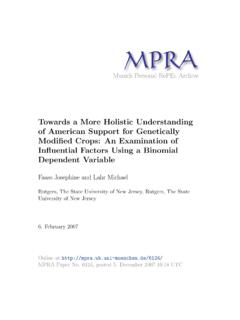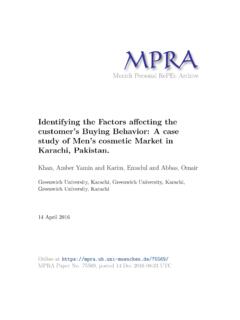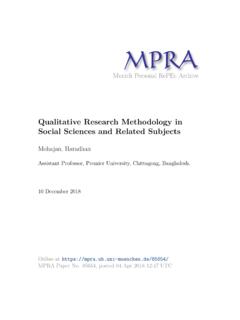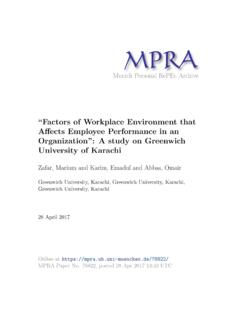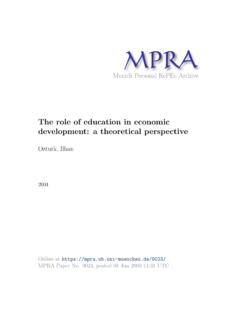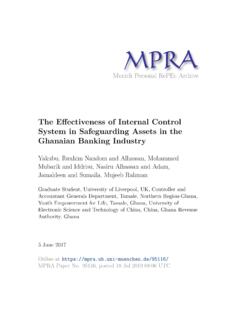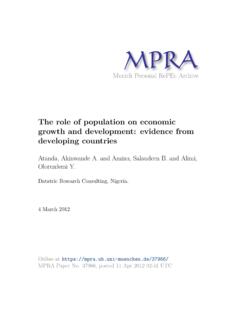Transcription of The First Industrial Revolution: Creation of a New Global ...
1 Munich Personal RePEc ArchiveThe First Industrial revolution : Creation of a New Global Human EraMohajan, HaradhanAssistant Professor, Department of Mathematics, PremierUniversity, Cgittagong, May 2019 Online Paper No. 96644, posted 24 Oct 2019 08:56 UTC Journal of Social Sciences and Humanities, Vol. 5, No. 4, 2019, pp. 377-387 The First Industrial revolution : Creation of a New Global Human Era Haradhan Kumar Mohajan Department of Mathematics, Premier University, Chittagong, Bangladesh Cell: +8801716397232, Email: Abstract The First Industrial revolution began in England in about 1750 1760 that lasted to sometime between 1820 and 1840. It is one of the most distinguished turning points in human history. During this period human and animal labour technology transformed into machinery, such as the steam engine, the spinning jenny, coke smelting, puddling and rolling processes for making iron, etc.
2 Industrial revolution is renewed for Global economic growth, increase in production and consumption of common people. The system of transportation communication through canals, road and rails had improved. Also banking and other financial systems improved to run the industries and business firms smoothly. Child and infant mortality rate decreased and fertility rate increased. As a result, population growth had dramatically changed. On the other hand, women and child labour has increased in dangerous and unhygienic condition. Factory workers have to work sixteen hours in a day merely to save the family from starvation. Industrial revolution created a wide gap between the rich and the poor. An attempt has taken here to describe the various effects of Industrial revolution .
3 Keywords: Industrial revolution , Technological Change, Human Capital, Economic Development 2 Haradhan Kumar Mohajan: The First Industrial revolution : Creation of a New Global Human Era 1. Introduction England is the First country where Industrial related productions have commenced. In the late of the 18th and in the beginning of the 19th century (1760 1840) there were enormous socio-economic changes in England which collectively known as the Industrial revolution (IR). It is called First Industrial revolution or simply Industrial revolution . The IR was a more relentless and universal success, than the Florentine Renaissance, or the French revolution (say) (Mathias and Davis, 1989). The IR was the transition from human and animal labour technology into machinery, new chemical manufacturing and iron production processes, improved efficiency of water power, the increasing use of steam power, and the development of machine tools.
4 The iron and textile industries played central roles in the IR (Ashton, 1948). The invention and improvement of the steam engine brings fruits in the IR. The engine was made of iron and fuelled primarily by coal. Coal played a vital role in the IR (Clark, 2007a). The IR transferred the rural industries into towns and craftsmen became the wage labourers. The British colonial countries were primary source of raw materials, such as cotton, sugar and tobacco, etc. England supplied slaves to Latin and North America through English ships to collect raw materials from those countries. But in 1793 slave trade was abolished (Hill, 1969; hobsbawm , 1968). One of the great technological advances came in 1712, with the invention of a steam engine by an English blacksmith, Thomas Newcomen (1664 1729).
5 In history his invention is consider as the atmospheric engine (Sinclair, 1907). This engine burned coal to create motive force that could be used to pump water out of the shafts of coal mines. Scottish mechanical engineer James Watt (1736 1819), working in a Glaswegian university lab of England, improved the Newcomen s steam engine in 1776, which harnessed massive amounts of coal-powered energy efficiently and economically (Jacob, 1997; Usher, 1920). This invention created the early modern Industrial era in the worldwide, which brings revolutions in textiles, mines, steam-powered railroads, steam-powered ocean freighters, steel production, and other areas of economic activities. This made massive expansion of cities, industries, and infrastructure of all kinds (Sachs, 2005; William, 2012).
6 Journal of Social Sciences and Humanities Vol. 5, No. 4, 2019, pp. 377-387 3 Before the IR in Britain most people lived in small villages. They travelled on foot or by horses through small paths. Illness was common because of inadequate food, poor hygiene, use of polluted water, and non-existence of sewage system. As a result, life expectancy was very short. About 80% people worked in small agricultural farms in rural areas and rest 20% people lived in small towns. The villagers worked from sunrise to sunset. Very few people worked in manufacturing, mining and trade units. Manufacturing was small and localized. People used handmade tools powered by people or animals. About 1% citizens were aristocratic who did not work. They only invested much of their wealth in land (Clark, 2010; Jacob, 1997).
7 Before the IR, people wove textiles only by hand but after the IR greatly increased output of machine-made goods. The IR was based on a surplus of cheap labour and the Creation of good quality items for the rich people who owned the land. Metal was worked manually minimum using the basic hand tools, such as hammers, files, scrapers, saws and chisels (Broadberry and Gupta, 2005; Gunderson, 2008). Scottish social philosopher Adam Smith (1723 1790) was the First economist to explain the workings of a modern economy in terms of specialization and the division of labour, efficiently market transactions, and an increase of productivity. He advocated an economic system based on free enterprise, the private ownership of means of production, and lack of government interference.
8 The economy is based on the doctrine of laissez-faire which is free trade without interference from the government. By this doctrine factory owners had independence to arrange working conditions in whatever way they pleased. As a result mercantilism took place in the society (Ashton, 1948). During the IR the average income and standard of living of common citizens have not increased. More workers gathered in cities where the factories grew and cities developed rapidly. As more people joined in factories, the percentage of farmers in the total population declined (Berlanstein, 1992). 2. Literature Review Jaume Ventura and Hans-Joachim Voth had shown that during the IR Britain s borrowing boom was beneficial for agricultural improvements, enhancement of textiles and iron industries that accelerated structural change of business and massive social change 4 Haradhan Kumar Mohajan: The First Industrial revolution : Creation of a New Global Human Era (Ventura and Voth, 2015).
9 Vijjika Singh has enlightened on technological advances through machines during the IR (Singh, 2015). Robert C. Allen has stated that the IR has started in Britain and the new inventions and technologies have changed the world. He stated that wages were remarkably high and energy was cheap in Britain than the other continents. Living standards of Britain rose generally due to economic developments (Allen, 1992). Harshit Agarwal and Rashi Agarwal have discussed the technological change and development of banking and financial firms during the 1st and 2nd IR. They have stressed that the invention of power loom and stream engine and improvement in the technology of iron making became the major reason behind the 1st IR. During the IR increased the number of country banks, the increased network of the joint and country banks and the coming of Bill-workers changed the banking and financing of firms (Agarwal and Agarwal, 2017).
10 Joyce Burnette indicated that during the IR the wage gap between female and male were very high. Men received two to three fold wages than women (Burnette, 1997). Patrick O Brien believes that England s productive and responsive agriculture, combined with its abundant and accessible endowments of coal and other minerals, foreign trade, and significance technological discovery and innovation are the causes or origins of the IR in England (O Brien, 2017). 3. Methodology of the Study Industrial revolution had begun in England which is considered as the turning point in human history. Before the IR common people of England were poor. During the IR social, cultural, and political situation has changed. The IR has created the new era. Many kinds of industries, such as Cort s puddling and rolling process for making iron that was reinvented by Henry Cort (1740 1800), Crompton s mule for spinning cotton that invented by Samuel Crompton (1753 1827), and the Watt steam engine had developed during the IR.

